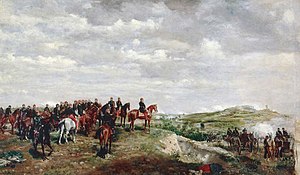| Second Italian War of Independence | |||||||||
|---|---|---|---|---|---|---|---|---|---|
| Part of the wars of Italian unification and the French-Habsburg rivalry | |||||||||
 Napoleon III at the Battle of Solferino, by Jean-Louis-Ernest Meissonier, oil on canvas, 1863 | |||||||||
| |||||||||
| Belligerents | |||||||||
|
|
| ||||||||
| Commanders and leaders | |||||||||
|
|
| ||||||||
| Strength | |||||||||
|
312 guns 90 guns[1] |
824 guns | ||||||||
| Casualties and losses | |||||||||
|
1,128 missing 17,054 wounded 2,040 disease related deaths Total: 25,720 casualties 3,572 wounded 1,268 missing[2] Total: Unknown |
Total: Unknown | ||||||||
The Second Italian War of Independence, also called the Sardinian War, the Austro-Sardinian War, the Franco-Austrian War, or the Italian War of 1859 (Italian: Seconda guerra d'indipendenza italiana; German: Sardinischer Krieg; French: Campagne d'Italie),[3] was fought by the Second French Empire and the Kingdom of Sardinia against the Austrian Empire in 1859 and played a crucial part in the process of Italian Unification.
A year prior to the war, in the Plombières Agreement, France agreed to support Sardinia's efforts to expel Austria from Italy in return for territorial compensation in the form of the Duchy of Savoy and the County of Nice. The two states signed a military alliance in January 1859. Sardinia mobilised its army on 9 March 1859, and Austria mobilized on 9 April. On 23 April, Austria delivered an ultimatum to Sardinia demanding its demobilization. Upon Sardinia's refusal, the war began on 26 April. Austria invaded Sardinia three days later, and France declared war on Austria on 3 May.
The Austrian invasion was stopped by the arrival of French troops in Piedmont that had begun in late April. The Austrians were defeated at the Battle of Magenta on 4 June and pushed back to Lombardy, where the Franco-Sardinian victory at the Battle of Solferino on 24 June resulted in the end of the war and the signing of the Armistice of Villafranca on 12 July.
Austria ceded Lombardy to France, which, in turn, gave it to Sardinia. Exploiting the collapse of Austrian power in Italy, Sardinia annexed the United Provinces of Central Italy, consisting of the Grand Duchy of Tuscany, the Duchy of Parma, the Duchy of Modena and Reggio and the Papal Legations, on 22 March 1860. Two days later, Sardinia ceded Savoy and Nice to France at the Treaty of Turin as compensation for its assistance.
- ^ Micheal Clodfelter. "Warfare and Armed Conflicts: A Statistical Reference to Casualty and Other Figures, 1500–2000", 4th Edition. 2017. Page 181.
- ^ a b Clodfelter, p. 181
- ^ Arnold Blumberg, A Carefully Planned Accident: The Italian War of 1859 (Cranbury, NJ: Associated University Presses, 1990); Arnold Blumberg, "Russian Policy and the Franco-Austrian War of 1859", The Journal of Modern History, 26, 2 (1954): 137–53; Arnold Blumberg, The Diplomacy of the Austro-Sardinian War of 1859, Ph.D. diss. (Graduate School of Arts and Sciences, University of Pennsylvania, 1952).